We offer this program on pioneer Los Altos Hills businessman
and family man William MacGregor Cranston. I imagine everyone
here has heard of and perhaps voted for United States Senator
Alan Cranston, Democrat from California, who represented California
in the Senate for 24 years, the longest period of any senator
since Hiram Johnson. William Cranston was therefore the father
of a famous son, but to a lesser degree, the reverse is true:
Alan Cranston was the son of a prominent father, whose legacy
is visible today in Palo Alto and on the peninsula.
The name Cranston is Scottish. A common conception of Scots is
rugged highlanders, kilted warriors swinging two-handed claymores
in battle against English monarchs or rival clans, living on porridge,
haggis, and whisky. Less picturesque but more numerous were Scots
of the Lowlands, roughly the area between Glasgow and Edinburgh,
where the majority of Scotland's population is today, and the
borders - Sir Walter Scott country. Scots of these areas were
mercantile: builders, wrights, and shippers.
Alexander Cranston, born 1822, left Scotland in 1831 aged 9 for
Canada, and married Marion Dickie. The couple had seven children,
one of whom was Robert Dickie Cranston, born 1849, who came to
San Francisco from Ontario in 1870. The 1874 San Francisco City
Directory lists Robert D. as "Carpenter, D.A. MacDonald &
Co." - MacDonald's a great Scottish name.
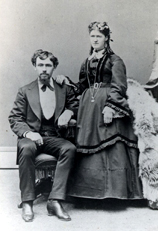 Robert
married one Jane MacGregor - there's another great Scottish name
- who was from Ayrshire, a county on Scotland's west coast whose
most famous son was Robert Burns.
Robert
married one Jane MacGregor - there's another great Scottish name
- who was from Ayrshire, a county on Scotland's west coast whose
most famous son was Robert Burns.
Jane MacGregor and Robert Dickie Cranston c. 1875
Robert and Jane had four children, one of whom was William MacGregor
Cranston, born 1879 in Yountville, Napa County, California.
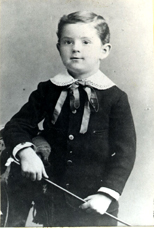
William MacGregor Cranston
Robert apparently moved a lot, as San Francisco directories list
him at various addresses and occupations, but by 1889, in partnership
with one Charles Keenan, he was a prominent builder in the Haight-Ashbury
District of San Francisco. Lots in the area were cheap, allowing
for construction of large multi-story mansions. The Haight-Ashbury
in the 1960's was briefly the most famous neighborhood in the
world, home of the hippie counterculture: the Grateful Dead, Janis
Joplin, Grace Slick and the Jefferson Airplane, etc. This is partly
because of homes like the ones Robert Cranston built, which were
later subdivided for multiple apartments with cheap rents, allowing
the influx of hippies who had little or no money. Many of Robert's
buildings can be seen today almost unaltered, at least from the
outside.
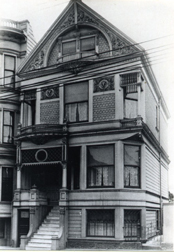 He built this residence for himself at 1777 Page Street, southeast
corner of Cole just a block from the Golden Gate Park Panhandle.
He built this residence for himself at 1777 Page Street, southeast
corner of Cole just a block from the Golden Gate Park Panhandle.
1777 Page Street c. 1900
The San Francisco City Directory for 1897 lists Robert D. Cranston
as "Architect and Builder," residence 502 Cole Street,
just around the corner from 1777 Page Street and adjoining it.
The same directory lists Robert's son, Robert A., William's older
brother, as "medical student." Robert A. would have
attended either Cooper Medical College at Sacramento and Webster
or the Affiliated Colleges (now UCSF) on Parnassus Heights.
It also lists Robert's son William as "student." William
in fact graduated in 1897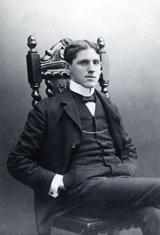 from Lowell High School, on Sutter Street at Octavia in San Francisco,
about two miles from the family home.
from Lowell High School, on Sutter Street at Octavia in San Francisco,
about two miles from the family home.
William Cranston c. 1900
Lowell was the first high school west of the Mississippi, and
was and is college-preparatory, with a reputation for high achievement
(and snobbishness). Graduates today include three Nobel Prize
winners, and a host of prominent figures in the arts, medicine,
and politics. From Lowell, William went to Stanford University
where he studied law, and met Carol Dixon, daughter of a Sacramento
physician. They both graduated in 1901 and were married in 1903
in Sacramento.

Carol Dixon
By 1905 William had joined his father and brother in the construction
business, which was now R.D. Cranston and sons, with offices at
114 Montgomery Street, just north of Market. William also had
a separate real estate business William Cranston & Co., in
partnership with one George Beevel. His residence was in Berkeley.
Then came April 18, 1906, the earthquake and subsequent fires
that destroyed practically all of commercial and retail San Francisco.
The disaster permanently changed Bay Area demographics. 250,000
San Franciscans were left homeless, some returning to the city,
others moving for good. William and Carol moved to Palo Alto with
their first child, son William, born in 1907. William Jr. died
of a rare infection in 1907. The couple had a daughter, Ruth Eleanor
("R.E."), born 1909, who would write a family biography.
William sold real estate "from the seat of a bicycle,"
according to R.E. In 1908 he organized the University Realty Company,
which would be prominent for 35 years.
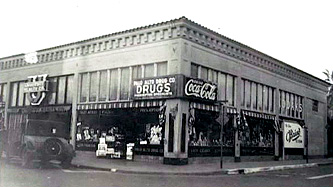
University Realty, Palo Alto, Waverley at University
c. 1930
In 1910 he took in a partner, fellow Stanford graduate Norwood
B. Smith. It was a pioneer realty business, and dealt with big
names in Palo Alto and the peninsula, among them Timothy Hopkins,
nephew of Mark Hopkins, and Mrs. C.F. Rengstorff. Seven years
after its founding, the Palo Alto Times reported the Cranston-Smith
firm's history in a story "Red Block U is for Useful."
Everyman has a story. There are interesting stories in Palo
Alto all the time that the public never hears of - stories of
joy and sorrow, of achievement and defeat, of invention and intrigue
- all kinds of stories…
A story of achievement and prosperity…is the story of the
University Realty Company of Palo Alto, the company that has its
big red block letter "U" painted on board signs along
the highways and byways where lots and farms are offered for sale,
all the way from San Francisco to Santa Cruz.
The two quiet young men who control this company are too busy
to be much in evidence in local affairs, although they take a
hand now and then. They are William MacGregor Cranston and Norwood
Browning Smith, both Stanford men. They gained a little experience
in San Francisco after leaving college, and returned to Palo Alto
and hung out their single with the red U in the center…
They have sold the big places in the forest wilds. Their customers
are capitalists and captains of industry who want wild native
places, such men as the Popes, the Crockers, the Laws and the
Hoovers. Big men of the Pacific coast came to have confidence
in the quiet-spoken, mild-mannered, but enthusiastic Palo Alto
young men who knew the wild country. It became known that a $50,000
deal could be safely entrusted to them, even if it involved many
details and had to be kept secret for months.
Now the University Realty Company manages some of the big estates
it has sold. The owners require agents near at hand to look after
the chickens and ducks. Smith and Cranston have just completed
three miles of asphalt paving through the George Pope estate at
La Honda, roadway as good as the state highway. A superintendent's
house and a model dairy barn will be another improvement this
summer.
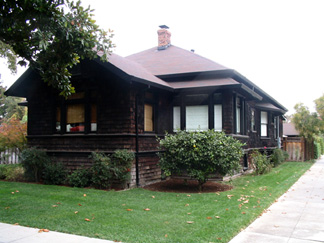 William
and Carol bought a house in Palo Alto at 1357 Cowper Street, a
fine example of the Arts and Crafts school, the exterior of which
is almost unaltered today.
William
and Carol bought a house in Palo Alto at 1357 Cowper Street, a
fine example of the Arts and Crafts school, the exterior of which
is almost unaltered today.
1357 Cowper Street, corner of Kellogg, Palo Alto, 2007
Photo courtesy of John Ralston
In 1914 their last child, son Alan MacGregor was born. The same
year William and Carol bought a 20-acre parcel of land in Los
Altos Hills at what is now the corner of Fremont Road and Campo
Vista Drive. The property included a big red barn and an old shingled
farmhouse, which was called the Red Barn House (the Winbigler
House would later be built on the property).
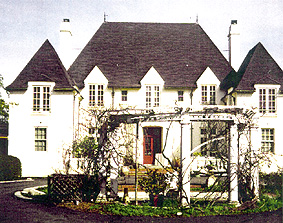
Winbigler House
Alan and his sister R.E. roamed the large property and rode horses,
enjoying their childhoods in a rural setting close to one of the
world's most famous cities.
In 1922 William and Carol moved to what would be their permanent
home, a large house at the end of what is now Cypress Court off
Cypress Drive, which intersects Edith Avenue, Los Altos Hills.
The house was on a 13-acre property along Adobe Creek. R.E. described
it as…a gabled rectangle, gray-shingled, white-trimmed,
with a green roof - a long, welcoming, friendly English house,
set far back on the land in a grove of century-old oaks on the
bank of the creek. An ancient ranch house by the creek and a little
shed in the field went back to much earlier times, almost certainly
to the days of the Mexican land grant.
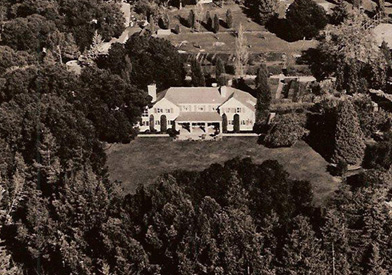 William
named the house "Villa WAREC," WAREC being an anagram
of the initials for William, Alan, R.E., and Carol.
William
named the house "Villa WAREC," WAREC being an anagram
of the initials for William, Alan, R.E., and Carol.
Aerial view of Villa WAREC c. 1930
The house still stands, but the property is subdivided and holds
several other large houses. Just off Cypress Drive is a cul-de-sac
called WAREC Way, a memento of the Cranston house's name.
University Realty, Palo Alto, thrived. It was mentioned in the
memoirs of Birge Clark, Palo Alto's leading architect in the first
half of the 20th century. In Mark Twain's Innocents Abroad
Twain's party, touring Italy, heard Michelangelo mentioned everywhere:
paintings, sculptures, historic buildings - this Michelangelo,
that Michelangelo. Finally Twain said "Enough! Tell us that
God made Italy from designs by Michelangelo!" Birge Clark
has an analogous position in Palo Alto: the Hamilton Street Post
Office, by Birge Clark; the original Palo Alto Clinic, by Birge
Clark; the Lucie Stern Community Center, by Birge Clark. It's
as though God made Palo Alto from designs by Birge Clark. Clark's
pre-eminence is due to two factors: the compatibility of his designs,
mostly Spanish Revival, with Palo Alto's heritage; and the fact
that Palo Alto being a town of only 6,000 population in the early
20th century, his architectural firm was the only one in town.
Clark wrote in his memoirs:
In the early '20's there was an active real estate firm, the
University Realty Company, also known as Cranston & Smith.
This firm felt that Palo Alto's business district was inevitably
going to grow down University Avenue, though in the early 20's
it had not crossed Waverley Street with any businesses except
for three little frame buildings, one of which was a cleaning
and dyeing plant and one of which housed an undertaker…
In 1923 Liddicoat's Market…was built. This was quite an achievement
for Norwood Smith of the University Realty. All of the original
tenants, seven in number, already had separate stores in Palo
Alto, and "markets" as such were almost unknown. There
was, however, a famous one in Santa Barbara, so Norwood promoted
this one for Palo Alto hoping it would be somewhat like that one
in Santa Barbara… There were several problems which developed,
but Liddicoat's eventually opened and became a very successful
market. Liddicoat was the butcher, Larsen the grocer, and then
there were smaller tenants for vegetables, delicatessen, cigar
maker, etc. - seven in all… Norwood Smith felt that you should
merely guide how a town wanted to grow and that in his opinion
the town wanted to go on down University Avenue and so there was
not much effort in promoting a building on the Avenue…
Cranston did not fully appreciate the need of any architect for
designing store buildings and personally built 125 feet of one-story
stores on the corner of Waverley and the west side of University
Avenue, and a two-story Decker Oak Building opposite, using a
construction firm for whom an architect named Powers made drawings.
In 1923 Norwood Smith bought out William Cranston's interest in
the University Realty Company. Smith and Cranston continued to
hold considerable real estate jointly, and University Realty Company
was dominant in Palo Alto. It arranged the acquisition of Waverly
and Hamilton streets for the downtown United States Post office.
The red U logo shows in this picture of the lot. The building
was designed by Birge Clark.
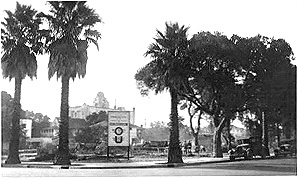
Site of main Palo alto Office, Waverley at Hamilton, c.1933
William Cranston took an extended tour of Europe. On his return
he resumed a real estate business in San Francisco, with offices
in the Alexander Building at 155 Montgomery Street, the same block
as his offices 20 years earlier before the earthquake and fire,
specializing in property management and the development of business
property. He was a member of the Bohemian Club, which holds famous
retreats at the Bohemian Grove in the redwood country. On the
daily commute train, he formed a friendship with another commuter,
newspaper editor Fremont Older.
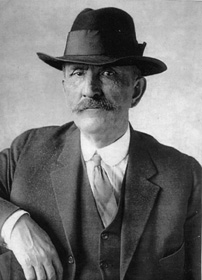 Fremont
Older c. 1919
Fremont
Older c. 1919
Older, a man of uncompromising rectitude, had instigated the
graft prosecution that shook up San Francisco in the years after
the earthquake and fire. In 1916 an anonymous terrorist bomb exploded
on Preparedness Day during a patriotic parade. Two labor figure,
Warren Billings and Thomas Mooney, were arrested, tried, and convicted
of the bombing. Older had thought Mooney guilty, but letters from
a chief prosecution witness indicating that prosecution testimony
was perjured were brought to him. Older's exposure of the prosecution's
malfeasance led to the owners of his paper demanding that he stop
it or be fired, but a last-minute offer by William Randolph Hearst
of the editorship of the San Francisco Call allowed him to continue
his work. Mooney had been sentenced to hang, but such an outcry
was raised that Governor Stephens commuted the sentence to life
imprisonment - which actually made no sense. Older continued to
fight for the release of Mooney and Billings.
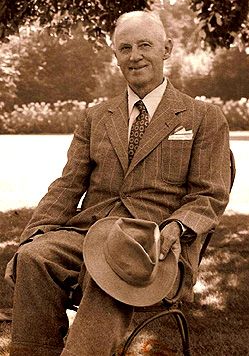
William Cranston
William Cranston had been a good Republican, active in the Palo
Alto Republican Club. Older had been instrumental in the Progressive
Republican wing, but was essentially an independent by the 1920's.
Cranston's contact with Older showed Cranston a side of life he
might not have seen otherwise. One day Older told Cranston he
was going to see Tom Mooney in San Quentin and asked "Want
to come along?" They went, taking the ferry across the Golden
Gate. Mooney had been in prison for about 15 years, and would
spend a total of 23 until his release in 1939. They talked, and
then Mooney broke down and cried. William Cranston would tell
the story to his son Alan.
Older's papers in the Bancroft Library, University of California,
Berkeley, contain a copy of a letter Older wrote William Cranston
when Cranston was a patient at the Sansum Medical Clinic in Santa
Barbara. Clinic founder Dr. William Sansum was a pioneer in the
treatment of diabetes, although it is unclear if Cranston was
afflicted with it. Older's letter refers to an article in the
Nation about his involvement in the Billings-Mooney case.
Fremont Older and his wife Cora, a published writer herself, entertained
often at the property they called "Woodhills" at the
end of Prospect Road above Cupertino. There were barbecues, and
guests swam in a pool below an adobe-style cabana. The Olders
were often guests at Villa WAREC. The 1930's were an intensely
political period, and the talk often turned to politics. In 1935
Europe was supposedly at peace, but Older could see what was coming
with Hitler in power. Alan Cranston remembered Older saying "Hitler
is a tyrant." Alan asked "Why?" to draw Older out,
adding "He's doing what he thinks right for Germany."
Older turned his large head towards Alan and said "Why -
he kills people."
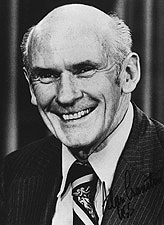
Alan Cranston
The depression set William Cranston's business in San Francisco
back. In 1932 he removed back to Palo Alto, doing business as
William Cranston and Company, a general real estate, property
management, and insurance business. His best friend Fremont Older
died in March, 1935 at the wheel of his car as he was returning
with Cora from a flower show in Sacramento. Older influenced Alan
Cranston to go into journalism. In Europe, Alan got an unexpurgated
version of Hitler's manifesto Mein Kampf (My Struggle) and had
it published in the United States in hopes of demonstrating to
Americans how dangerous Hitler was. Hitler's agents sued for breach
of copyright and had the publication stopped; Alan would always
be proud of having been sued by Hitler. Tom Mooney was pardoned
by newly-elected Governor Culbert Olson in an emotional ceremony
at the state Capitol in Sacramento. Alan Cranston drove Cora Older
to the ceremony.
University Realty Company filed dissolution papers in 1943. Many
of its buildings can be seen in Palo Alto today.
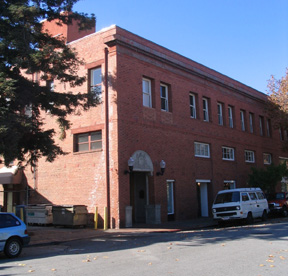 The Decker Oak Building was remodeled in 1984, with a new façade
on the University Avenue and Waverly elevations. The rear retains
the original brick wall.
The Decker Oak Building was remodeled in 1984, with a new façade
on the University Avenue and Waverly elevations. The rear retains
the original brick wall.
Decker Oak Building, Waverley at University, Palo Alto, 2007
Photo courtesy of John Ralston
Liddicoat's became a multi-ethnic restaurant mall, notable for
having the original location of Mrs. Field's Cookies. The mall
closed in the 1990's and the building was remodeled.
The offices of University Realty at the northwest corner of University
and Waverly are now a furniture outlet. R.E. Cranston Fowle is
still with us, living at the Sequoias in Portola Valley at the
time of writing.